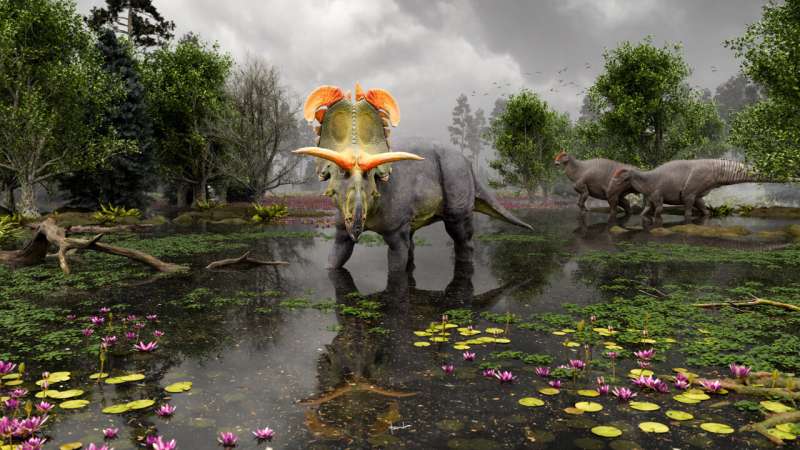
Reconstruction of Lokiceratops in the 78-million-year-old swamps of northern Montana, while two Probrachylophosaurus pass in the background. Credit: Fabrizio Lavezzi
What did scientists do this week? Exactly four things, all of which are summarized below.
“This Sweet Baby Can Hold 4.3 Million Suns”
Supermassive black holes: How do they get so big? This simple question is much more complicated than it sounds. Science is annoying. But an international team of astronomers may have found an answer. In the relatively nearby galaxy ESO320-G030, which surrounds a supermassive black hole, they discovered a powerful rotating magnetic wind.
They chose the galaxy to observe because it is very active, forming new stars at a rate 10 times faster than our galaxy, and is therefore very bright in the infrared, making it possible to capture details in the center of the galaxy. galaxies otherwise obscured by visible light and dust clouds.
Using ALMA, they peered through the surrounding dust to zoom in on the dense gas around the black hole. They could discern patterns in the gas that strongly suggest the presence of a rotating, magnetized wind. Unlike other types of winds and jets, which tend to blast matter away from supermassive black holes, the magnetic wind can feed material into the black hole, expanding it over time. Researchers say the process is analogous to how small stars accumulate matter, albeit on a much larger scale.
The Modesty League of Germs
Binge drinking is generally defined as consuming a large amount of alcohol in a short period of time, leading to a blood alcohol concentration of 0.08% or higher. Binge drinking behavior has short-term health risks, but also carries an increased risk of alcohol use disorder later in life. Although young people have reported decreases in illicit drug and alcohol use in recent years, researchers find that many young people regularly drink to excess.
Current support for alcohol use disorder is primarily through interventions such as therapy and peer-led mutual help groups such as Alcoholics Anonymous, as there are few approved medications available; researchers are interested in developing new and more effective pharmaceutical treatments.
A team at the University of Connecticut School of Medicine reports that binge drinkers have different patterns of microbiota in their guts than non-drinkers; Their gut microorganisms also produce a diverse mix of short-chain fatty acids associated with the fermentation of undigested dietary fiber and protein. They theorized that the microbiome could influence drinking behaviors.
Using mice trained to express binge drinking behavior, the researchers investigated whether changes in diet exerted an influence on drinking patterns. The rats were allowed to drink alcohol at night for four nights, and during the experiment, they were fed different types of short-chain fatty acids in their food for 10 days. The researchers found that increasing valeric acid in their food corresponded to a 40% reduction in alcohol consumption in the engineered mice.
“Multiple mechanisms likely play into how valerate reduces drinking,” says UConn School of Medicine microbiome scientist Yanjiao Zhou. “But the influence of this microbial metabolite on brain epigenetics may be quite powerful in regulating drinking behaviors.”
When 3.14 isn’t good enough
A team of researchers at the Indian Institute of Science modeling high-energy particle interactions accidentally discovered a new series representation for pi. Because these interactions involve so many parameters, one of the researchers was tasked with the optimization. Using the Feynman diagram, a mathematical representation of the energy exchange during particle interaction and scattering, and the Euler-Beta function, they managed to optimize their model of particle interactions, but also produced a new representation of the pi series by combining parameters specificity such that researchers can quickly arrive at the value of pi, which can then be incorporated into calculations.
“Our efforts, initially, were never to find a way to see pi. All we were doing was studying high-energy physics in quantum theory and trying to develop a less-parameter, more accurate model for understand how particles interact. We were excited to get a new way to look at pi,” says Aninda Sinha, professor at the Center for High Energy Physics.
The new dinosaur just dropped
A multi-institutional team of paleontologists reports the discovery of a new plant-eating dinosaur in northern Montana with a spectacular set of horns paired with the headdress worn by Loki, the trickster god in the Marvel Cinematic Universe. And since the specimen is now in Denmark, the researchers went ahead and named it Lokiceratops rangiformis. The fossilized bones were discovered in 2019, two miles south of the Canadian border.
After assembling the skull fragments, Colorado State University researcher Joseph Sertich and University of Utah professor Mark Loewen realized they had discovered a new species. Lokiceratops lived about 78 million years ago; the same rock layer yielded the remains of four other species, indicating that they had all lived at the same time. They estimate that Lokiceratops was 22 feet long and weighed 11,000 pounds, making it the largest of the centrosaurine horned dinosaurs in North America.
“This new dinosaur pushes the envelope of the strange ceratopsian head covering, with the largest horns ever seen on a ceratopsian,” Sertich said.
© 2024 Science X Network
citation: Saturday Quotes: Black Hole Tips; microbes affect the drink; The New Dinosaur Just Dropped (2024, June 22) Retrieved June 22, 2024 from https://phys.org/news/2024-06-saturday-citations-bulking-black-holes.html
This document is subject to copyright. Except for any fair agreement for study or private research purposes, no part may be reproduced without written permission. The content is provided for informational purposes only.